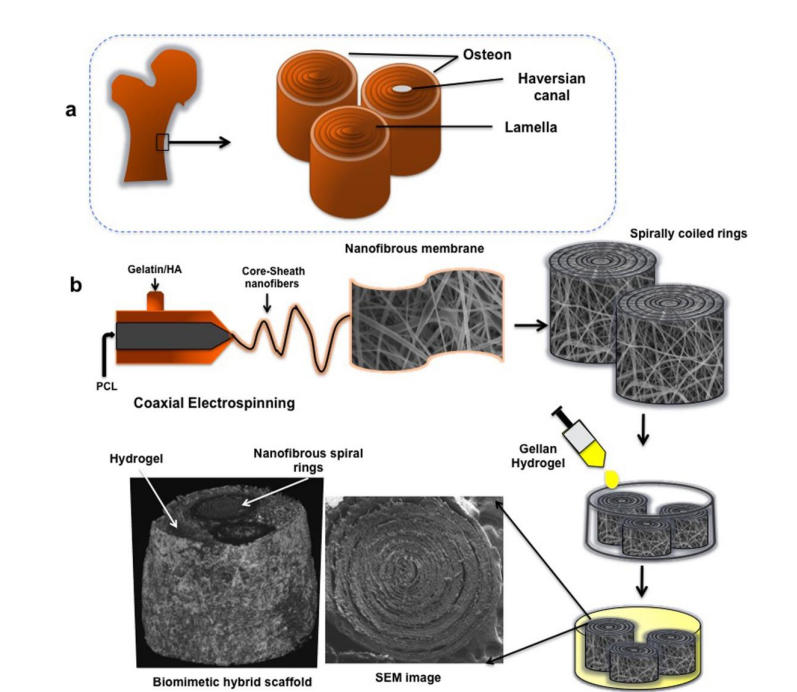A 3D hybrid scaffold comprising core-sheath nanofibers (gelatin/PCL with HA) and gellan gum-based hydrogel is developed to mimic natural bone. Nanofibers are coiled into spiral osteon-like structures and embedded within a porous hydrogel matrix to achieve mechanical integrity and biological functionality without external growth factors.
Bone disorders such as trauma, osteoporosis, avascular necrosis, and skeletal abnormalities often exceed the natural self-healing potential of bone. Current treatments like autografts and allografts are limited by donor site morbidity, ethical concerns, and risk of disease transmission. Existing tissue-engineered scaffolds lack architectural and mechanical mimicry of natural bone.
- Osteon-like Architecture: The scaffold features spiral coiling of nanofibers that closely replicate the microstructure of natural osteons found in bone.
- Core-Sheath Nanofibers: It incorporates nanofibers with a polycaprolactone (PCL) core for mechanical integrity and a gelatin/hydroxyapatite (HA) sheath to enhance bioactivity and support cell adhesion.
- Porous Hydrogel Matrix: The scaffold uses a gellan gum-based hydrogel with vertical pore architecture (~350 µm), which facilitates nutrient transport, cell migration, and vascularization.
- Enhanced Mechanics: The reinforced structure significantly improves compressive strength, achieving 13.9 MPa in the dry state and 9.1 MPa in the wet state.
- Sustainable and Cost-Effective: The use of microbial gellan gum and exclusion of animal-derived materials or expensive growth factors makes the scaffold affordable and suitable for clinical translation.
Lab-scale prototype has been fabricated using electrospinning and manual coiling of nanofibers followed by embedding in crosslinked gellan/HA hydrogel. It has been validated through SEM, TEM, 4D X-ray imaging, swelling/degradation assays, cell adhesion (MG63), MTT, DNA quantification, ALP, and ARS assays.
The technology is ready for preclinical trials.
4
This low-cost, growth factor-free bone scaffold addresses a pressing need for effective, scalable solutions to treat critical bone defects. It has potential to reduce healthcare costs and improve recovery outcomes in orthopedic applications, especially in resource-limited settings.
- Bone Repair in Orthopedics and Trauma Care: Supports regeneration in critical-sized bone defects caused by injuries or surgeries
- Dental Bone Grafts: Can be used to restore bone loss in dental surgeries, such as implant placements
- Implants for Osteoporosis-Related Fractures: Provides structural support and promotes healing in weakened or porous bones
- Customizable Scaffolds for Regenerative Therapies: Allows tailoring of scaffold properties for patient-specific bone regeneration needs
- Biomedical Material Development: Serves as a platform for developing advanced, biocompatible bone repair materials
Geography of IP
Type of IP
201821005456
374883

